How to learn to skate?
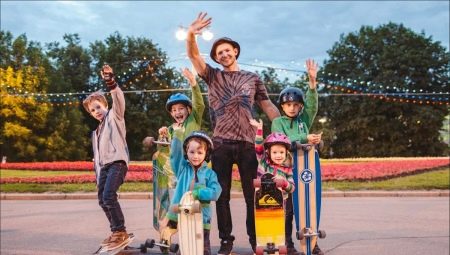
The skateboard is a modern sports unit popular with teenagers. At first glance, it is easy to learn, but in reality skateboarding is a special art that requires a lot of practice. In this article, we'll walk you through the steps of how to learn how to skate.
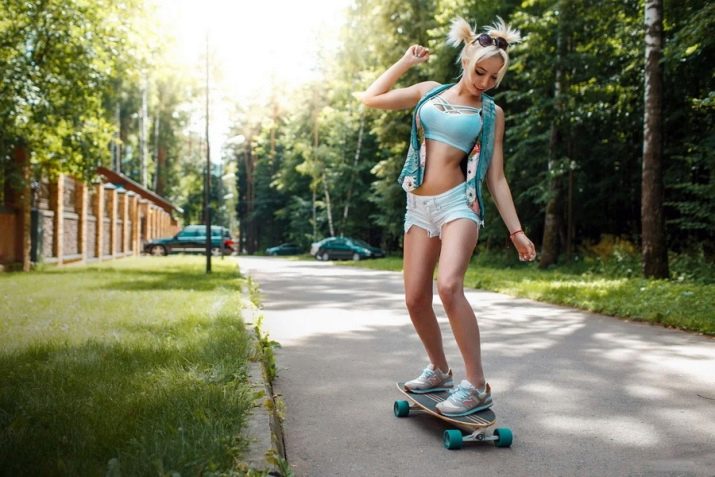
Peculiarities
Skateboarding is a very popular street sport among young people. In some countries, he has become a cult. A skateboard is much more than a vehicle as it requires stamina, strong legs and a sense of balance. This kind of sport is difficult to master and requires a huge amount of time, effort and patience. It will not be possible to master it completely, because more and more new tricks are constantly being invented that I want to repeat.

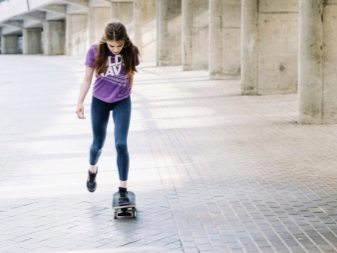
Daily skateboarding can be considered part of a healthy lifestyle, if you do not take into account the fact that it is a very traumatic sport.
It is important to understand that the most common injuries sustained when falling off a skateboard are in the hands and head. Protecting these parts of the body should be approached more responsibly.... Of course, there will be newcomers who will be sure that they can do without the "extra" protection. In this matter, wearing protective equipment is everyone's personal business. Before choosing the protection you need, remember that a serious injury could permanently discourage you from using this sports unit again.

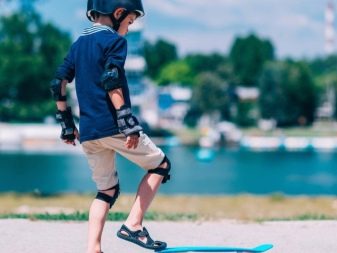
Fundamental rules
This sport is difficult to learn and requires a lot of practice and thoughtful approach. Overall success depends on many factors and adherence to a number of basic rules. So, it is extremely important to make sure of the reliability and safety of the skate, equipment, you need a competent choice of a place for riding and protection. Let's consider the listed items in more detail.
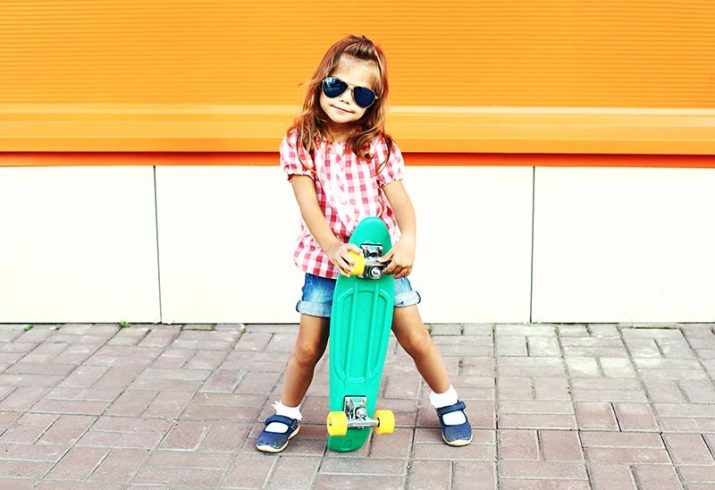
What should be a skateboard?
One of the most important rules is choosing the right skateboard for the learning process. To successfully choose your first skateboard, you need to consider what is in its design. Pay attention to the following main details.
- Board (deck). Carrying part of the skate. Its width can range from 4.6 to 10.6 inches. For the first deck, it is best to choose a medium size - 8 inches. It will be optimal for training, and as you improve your skills, you will understand whether you need a deck wider or narrower. A narrow piece will give you more maneuverability, while a wide piece will provide good stability.
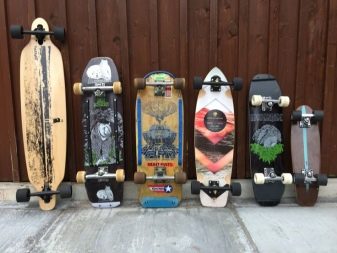
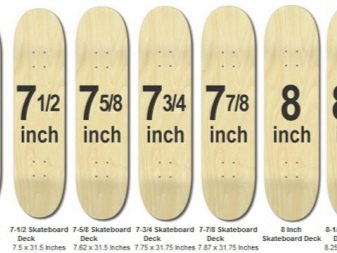
- The length of the board is not so important when choosing, as it has little effect, and the beginner will not notice the difference. The optimal shape of the deck can only be found by trial and error in the process of riding. When choosing this base, you should pay attention to the type of wood from which the board is made. The highest quality boards are made from maple. The number of layers of wood should be from 7 to 9. After gluing and shaping the deck, a special non-slip coating similar to sandpaper is glued onto it. Some deck models have a plastic coating on the underside to improve sliding on the railing.
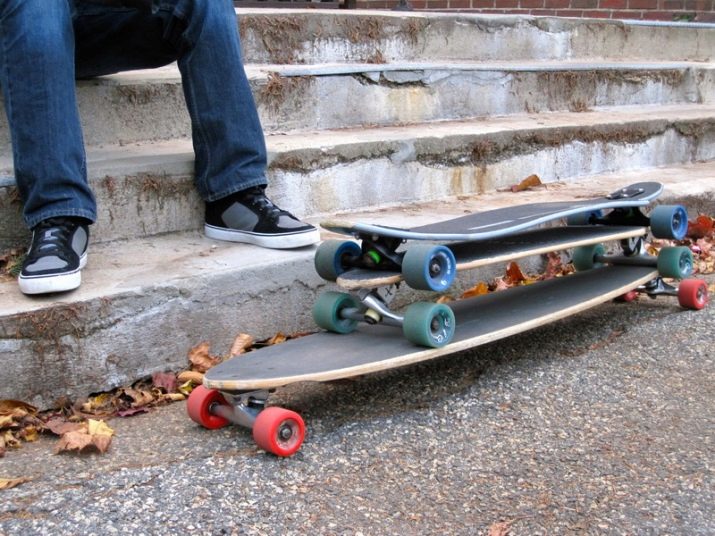
- Wheels. They have different diameters and stiffness. Soft wheels will provide a more comfortable and comfortable ride and ease of control, but they will not be able to pick up speed. In addition, such elements wear out faster, which will lead to more frequent replacement. Wheels with a medium stiffness are well suited for driving on a flat asphalt surface. Their diameter can have parameters from 50 to 180 mm. In order to learn how to skate, a wheel size of 54 mm is suitable.

- Suspension... This is the wheel-to-deck connection. Basically, these parts are made from an aluminum alloy, but there are also steel ones. They are more durable and much heavier. The more massive the suspension, the stronger it is, but the overall weight of the skateboard increases. For a beginner skateboarder or child, an aluminum harness is fine.
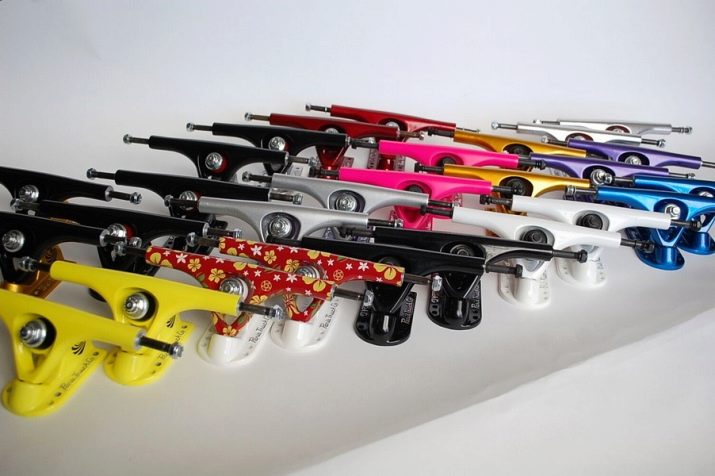
- Bearings... High-quality bearings are able to ensure not only the speed of the sports unit, but also its safety. In this case, it is best to use the products of trusted brands (Reflex, Independent, Bones, Lucky, Tensor, Speed Demons, Shake Junt).
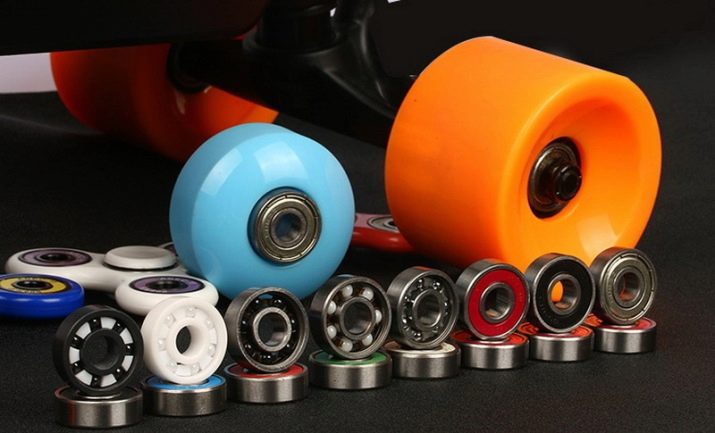
Remedies
The main rule of skateboarding is to wear protective ammunition. Unfortunately, both professional skaters and beginners very often neglect these simple and necessary things, which sooner or later leads to injury. It often happens that it gets very hot in the protection, so they take it off.
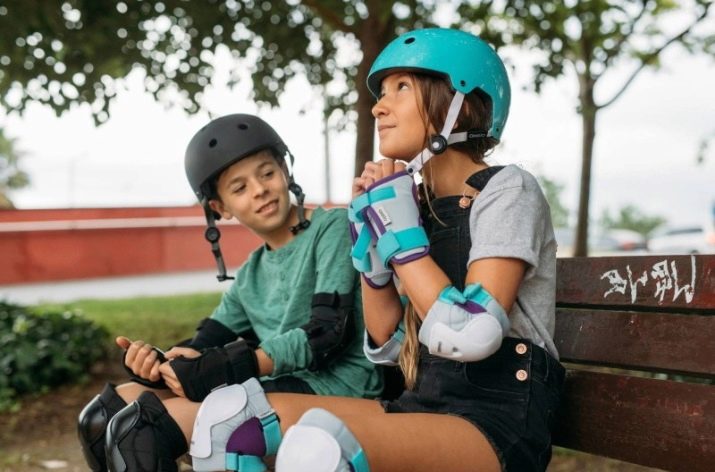
Inappropriate equipment can be uncomfortable, chafing or pinching your skin.
A standard set of skater protective gear consists of:
- knee pads;
- shoulder pads;
- helmet.
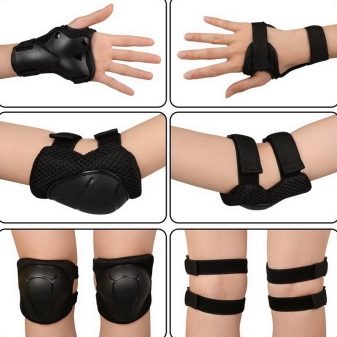
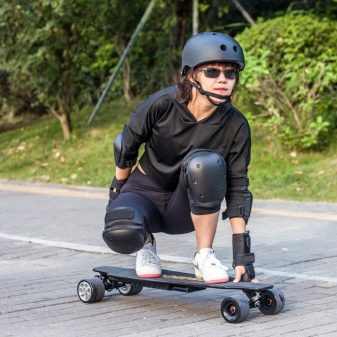
The safety helmet must have a smooth surface and a strong strap at the bottom (at the chin). It is better to buy this piece of protective ammunition in specialized stores. It is not worth saving on your own safety.
If you are faced with a choice of what kind of protection to buy, then it is best to choose reliable and most suitable products that fit tightly to the body. Protective ammunition should not slide or press. The best option would be velcro fastening.
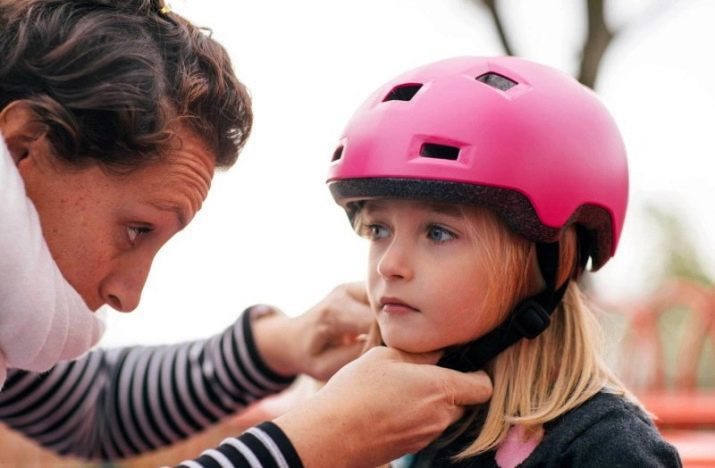
Remember, protection must be protective against injury, not just present. The price of such things directly depends on the degree of their effectiveness - the worse the protection, the more serious the injury can be.
Clothes and footwear
Finding the right clothes for a beginner skateboarder will be useful. It should be suitable in several ways:
- convenience - this is a very important parameter when choosing, clothes should be loose, not constrain or constrain movement in different positions, but also not be too loose;
- material strength - no one is immune from falls, especially a beginner, so your clothes must withstand friction against the asphalt surface and be resistant to such effects;
- material - it is best to choose breathable materials, this will allow you to sweat less during your workout.
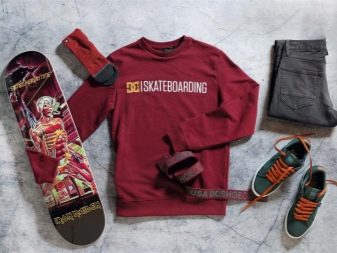

At first, it is not always advisable to purchase clothes and shoes from well-known brands, since clothes are consumables that will inevitably tear, get dirty and become unusable.
To learn to skate, you need to stock up on the right shoes. A very important part of the equipment is skate shoes, they are also called skate shoes, skate shoes and skate sneakers. They differ from ordinary sneakers only in the sole, which has a special coating, which provides additional traction with the deck. This hold allows you to perform many complex tricks.
In addition to the sole, such shoes have special shaped patches, a shock-absorbing sole filling and additional characteristics inherent in this or that model, which will not be striking when viewed, but will be felt when riding on a board.

Accessories
Very often you can see a large backpack on the back of a skater. This is a very useful accessory. There, athletes put everything they need for the field repair of their sports equipment, namely:
- tool;
- spare wheels;
- spare suspension;
- protective equipment.
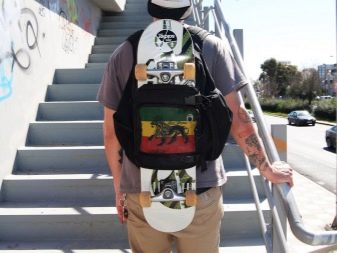
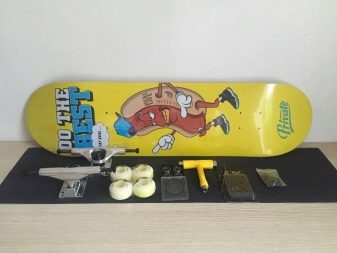
On some backpacks, you can find an additional mount for a spare deck. The rest of the space in the backpack is filled at the discretion of the athlete himself. This may include a first aid kit, replacement shoes, or clothing.
How to learn to stand on a skateboard?
Once you have purchased all the necessary skateboarding equipment, you can start training. First you need to get used to the newly purchased skateboard, learn how to get up on it. To do this, place the board on a flat surface, stand on it and try to stand. From the outside it may seem like an elementary affair, but in fact it is not so easy. The skate will "try to jump out" from under the rider. Try going down and back on the board.
Learn to balance, stay in one place and keep balance. When you have mastered balancing, then begin to smoothly move the center of gravity across the board, alternately moving it to the front wheels, then to the rear.
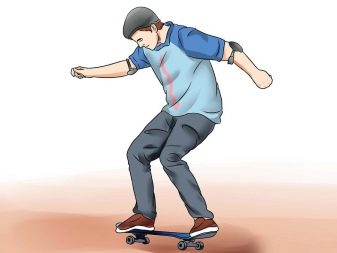

Once you've mastered this exercise, start jumping a little while standing on your skateboard. The first jumps are the most dangerous, because after landing the board will "try" to slip out. Additional fall protection can be used while getting used to the board. Here you can be helped by a person or a support that you can grab onto if you lose your balance.
When light jumps on the board will be given to you without problems, we can assume that you are accustomed to the unit and can control it, while at the “beginner's” level, but this is already a result. Next, it is allowed to start working out the rack.
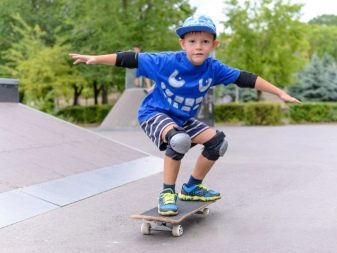

Further comfortable riding will depend on a well-placed stance. You must lean on one leg - it is the support, and the other is the jogging, you push off with it while riding.
After pushing, the jogging foot is on the back of the board, while the pivot foot is on the front of the board and practically does not move. You should place your feet across the board.


There are several ways to determine which leg will be the jogging and which will be the supporting one.
- Watch yourself - with which foot do you start walking, with which you begin to climb the stairs. It is this leg that will be the support for you.
- Another option for determining the pivot foot is tossing the ball into the air. Which foot will be easier and more convenient to hit it off - that will be the supporting one.
- The third option is reflex. Ask someone to push you a little. Reflexively, you expose your supporting leg so as not to fall.
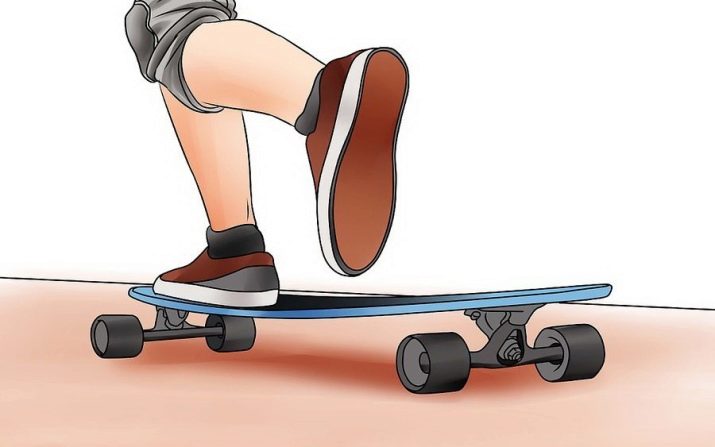
To finally understand if you were not mistaken with the choice of the supporting leg, you will succeed only in the learning process.
How to go?
After you are confident in your standing on the board and you have decided on the "leading" foot, you can try skateboarding. This will require an even, hard surface. Standing on the board, you will need to push off with a "jogging" foot and, keeping balance, keep on the skateboard.
It is advisable to perform one long and strong push. Often, beginner skaters are afraid of not staying on the board with such a take-off, and instead of one long push, you can see several weak take-offs. With this technique, it is impossible to achieve a smooth ride, it is much more difficult to maintain balance. Beginners will need to master the strong push.
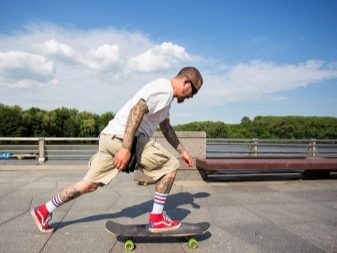
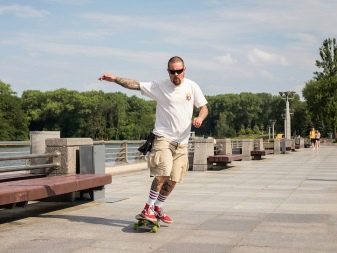
In addition to correct take-offs, there are also nuances, the knowledge of which will help to ride the board correctly.
- For safety while riding a skateboard the supporting leg is best placed behind the front screws. In this case, when pushing off, you will not be threatened by an uncontrolled forward tilt of the board.
- It is advisable to place the jogging leg at the back of the skate, at its very end. This position will allow you to better control the board and, if you need to turn or make a sudden stop, do not change the position of the jogging leg, but immediately start the maneuver.
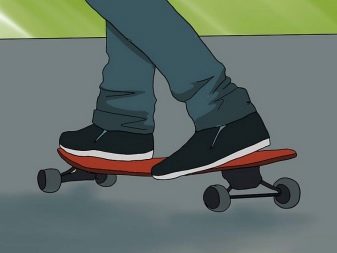

Learning to turn
To learn how to control the board, you need to balance well on it. If you have not fully mastered the technique of balancing on a skateboard, then attempts to turn may end up for you in a fall. If you are confident in your abilities, then you can start mastering this stage.
To complete the turn, you must as much as possible transfer your body weight forward relative to the feet for a right turn. To perform the left pivot maneuver, you will need to shift your body weight backward relative to your feet.
To practice cornering, you need to choose a level surface with enough room to maneuver. Riding at this moment should be calm, not very fast. The faster you move, the sharper the turn will be. On your first attempts, your main concern is not to fall.
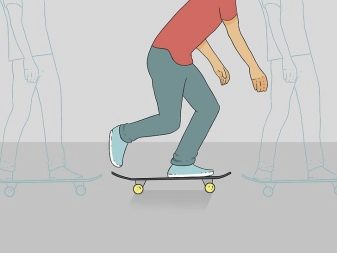
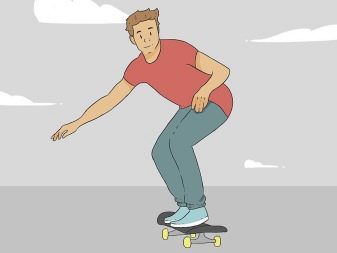
Gradually, you will begin to feel the necessary tilt and degree of pressure on the edge of the board, but this will come with time.
Sometimes there will be obstacles on your way that you will notice at the very last moment, and in order to go around them, you will have very little space. In such a situation, the way of turning will come to the rescue, which is combined with one of the simplest tricks called "kickterning". To perform this trick, you need to press slightly with your back foot on the back of the board ("tail") so that the front part ("nose") rises slightly above the floor.
Next, you need to turn the entire body in the direction of the turn. This set of actions should constitute a single action. The pressure on the deck should be gentle but fast. In this case, the control of the skate will be carried out with a sharp jerk of the whole body to the side.
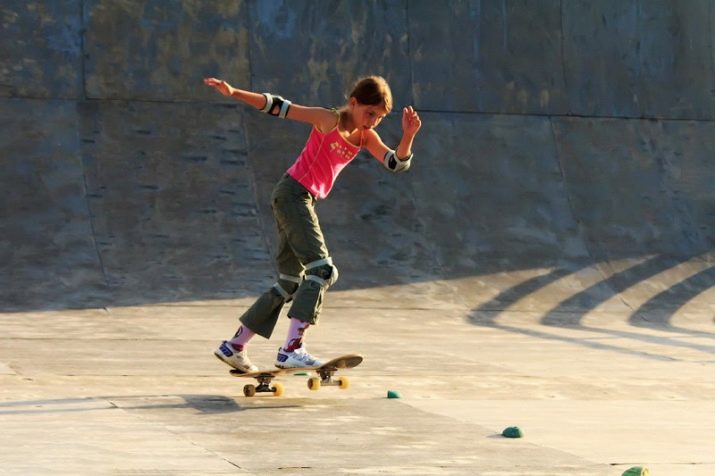
How to brake?
Correct and timely stopping is an important process in any movement, and skating is no exception. There are several ways to stop on a skateboard.
- With short touches of the floor, gradually slow down. This is the easiest way to stop, but not the most spectacular, and it will wear out your shoes a lot.
- You can stop using the principle of tail braking. In this case, weight is transferred to the back of the skate, causing the back of the board to contact the road. In this case, a quick stop occurs. In this way, you can not only brake, but also slightly slow down, if you are good at balancing on 2 wheels. With this method of braking, wear is transferred to the deck, its edges are quickly erased.
Flat skateboards are particularly affected by such braking. On sale are options for decks with plastic protection, which will extend the life of your board. For beginners, this proposal is very relevant.
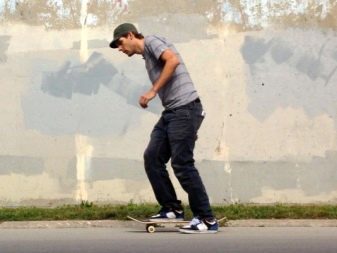
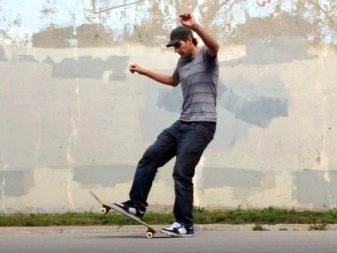
How to learn to fall properly?
In this sport, falls cannot be avoided, but they can be made less traumatic. To do this, you need to master the technique of falling and do not forget about personal protective equipment. When falling, you should group in such a way that the landing falls on the back of the shoulder, followed by rolling onto the back.... In this case, it is necessary to press your elbows to the body, cover your head with your palms from impact.
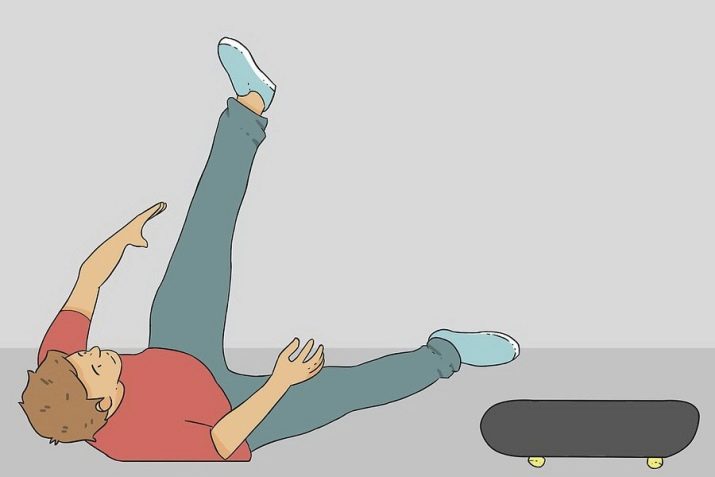
You can minimize falls when choosing a floor covering for skating. An uneven ground can cause seasoned skaters to fall, not to mention beginners.
Various tricks
Mastering tricks is given to everyone in their own way. Someone masters the basic elements in a few months, while others take years. In this sport, everything is individual. We list and consider the basic tricks, without which you cannot master more complex ones:
- ollie - jump with the board;

- manual - balancing on one skateboard suspension, as on two;

- zeros - jump with a click forward;
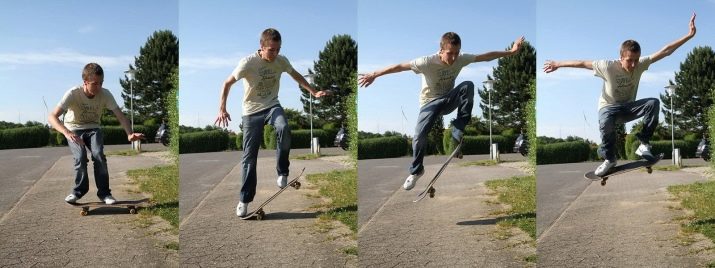
- flip - more difficult jump: after jumping, the board should rotate in flight;
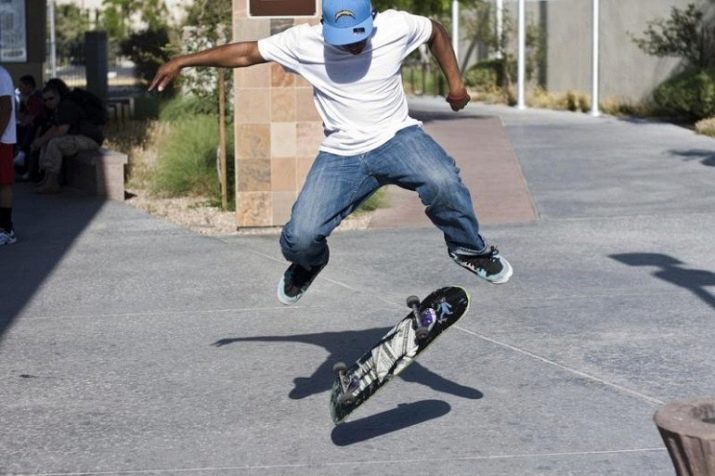
- slide - sliding on the board;
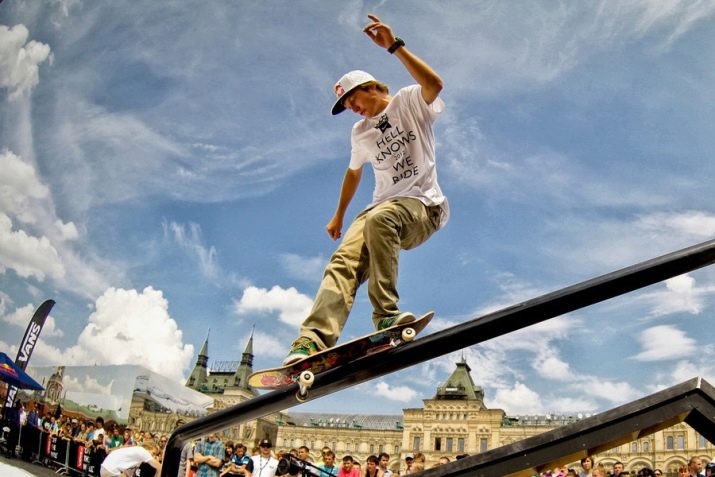
- rowed - when performing this trick, the board is gripped by hands;
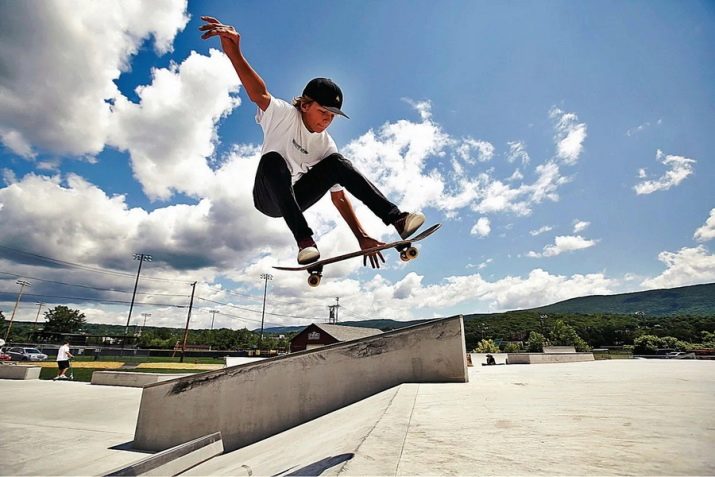
- stand, linden, stele - when performing these tricks, it is necessary to maintain balance by jumping on any object.
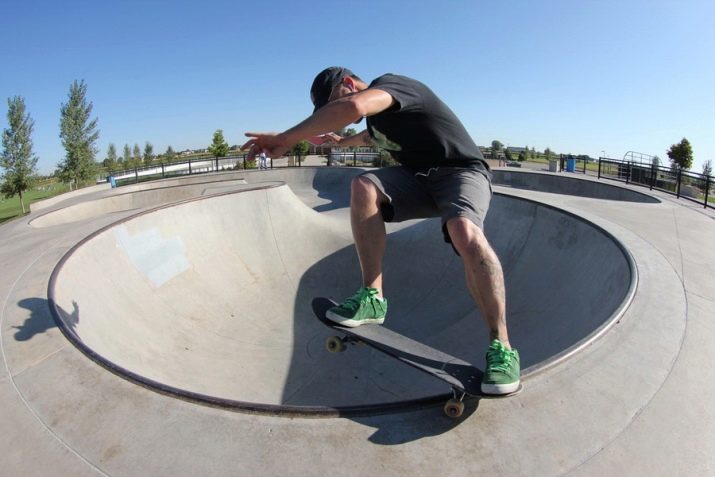
This sport is easiest to learn in childhood. Skateboarding is a good way to build endurance and coordination in your child. You can start training from the age of 3. To do this, you will have to get a smaller version of a regular skate, which is made by most of the major manufacturers. Such decks are 17 cm wide and 70 cm long. Children's riding technique is no different from adults. The little rider must be kept under control at all times. Parents will need to be nearby, to monitor all the actions of the child.

Useful Tips
Before mastering the difficult art of skateboarding, it is worth listening to some helpful advice.
- Before each workout, you need good warm-up, this will allow you to avoid sprains and dislocations.
- In skateparks you can meet other more experienced skaters who can help you learn to skate faster.
- Take your time to master the tricks. Begin with good board and body control.
- For fast results learn the theory of each trick step by step, practice all the movements as high quality as possible, this will allow you not to make mistakes.
- Before heading off to another workout must see the skate. It must be in good condition with no damage or loose parts.
- Try not to roll on small pebbles... On a road like this, it is easiest to lose balance, which leads to falls.
- Never compete in skill with more experienced skateboarders who have mastered difficult tricks. Often in such situations, beginners, in order to show their (not yet richest) skills, receive serious injuries and fractures.
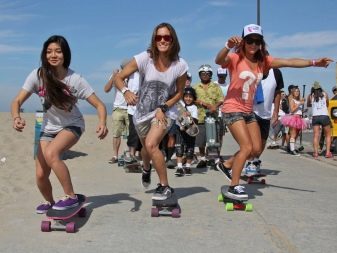
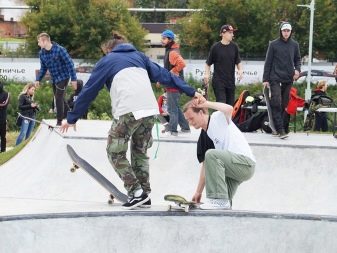
For information on how to learn how to skate, see the next video.








